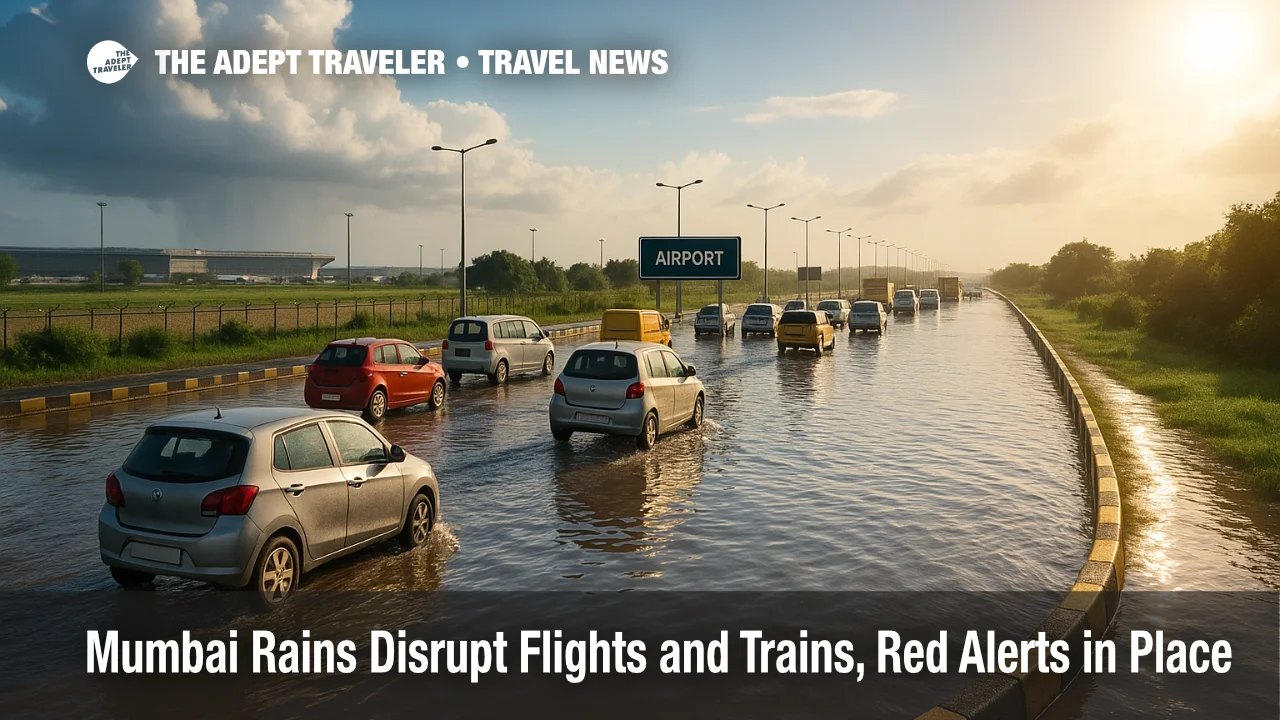Mumbai rains disrupt flights and trains, red alerts in place

Heavy monsoon downpours across Mumbai led to widespread waterlogging on August 18, 2025, prompting red alerts from forecasters and city officials. Chhatrapati Shivaji Maharaj International Airport (BOM) reported longer taxi and departure queues, with at least one diversion and several go-arounds due to poor visibility. Suburban rail services slowed as standing water covered low-lying track sections. Authorities urged travelers to check status updates, allow extra time, and avoid nonessential trips as conditions evolve into August 19.
Key Points
- Why it matters: IMD red alerts signal a high likelihood of extremely heavy rain that can disrupt transport and essential services.
- Travel impact: Flights at BOM faced average delays near an hour, with one diversion and multiple turn-backs reported.
- What's next: Forecasts keep heavy to extremely heavy rain in the outlook for August 19 in parts of Maharashtra, including Mumbai.
- BMC issued citywide advisories, including cautions about high-tide flooding and waterlogged corridors.
- Central and Western suburban lines reported slower operations where tracks were inundated.
- Several districts near Mumbai also remain under high-risk weather alerts.
Snapshot
Mumbai's red alert arrived alongside rapid rainfall rates that flooded key junctions and underpasses, creating long backups on the Western Express Highway and other arterials. At the airport, reduced visibility forced go-arounds and lengthened departure queues. Airlines and the airport authority issued advisories urging travelers to verify flight status before heading out, and to arrive earlier than usual. On the rails, low-lying sections of the Harbour and Main lines saw delays as pumps cleared standing water. Local officials highlighted the risk of fresh flooding at high tide and asked residents to limit movement to essential trips. With alerts extending into August 19, additional knock-on delays remain possible.
Background
Mumbai's core travel network is highly exposed during peak monsoon bursts, when short, intense cells can overwhelm drains and cover tracks and roadways within minutes. The India Meteorological Department's red alert is reserved for periods when extremely heavy rain is likely, a signal for agencies to mobilize pumps, traffic management, and rescue resources. Brihanmumbai Municipal Corporation operates a citywide control room and shares tide and waterlogging updates, which matter for neighborhoods around low bridges, subways, and coastal corridors. Aviation operations at Chhatrapati Shivaji Maharaj International Airport, BOM, are designed to continue in poor weather, but visibility drops and wind shifts can force diversions and go-arounds. Suburban railways typically slow to maintain safety margins where water crosses the running rails.
Latest Developments
Mumbai rains trigger advisories, with flight delays and rail slowdowns
The IMD's August 18 bulletins outlined extremely heavy rain potential over Konkan, including Mumbai, through August 19. The city government elevated messaging with a red alert and urged residents to avoid nonessential travel. At the airport, advisories warned of delays and recommended earlier arrivals for security and check-in. Media and ATC sources reported one diversion, multiple go-arounds, and average departure delays around 56 minutes during peaks. On the rails, Central Railway reported localized waterlogging, with Harbour and Main lines running behind schedule by roughly 10 to 15 minutes, while Western Railway kept services moving using extensive dewatering. Live traffic cameras and police updates showed persistent backups at low-lying junctions and underpasses. Districts adjacent to Mumbai, including Thane and Palghar, remained under heightened alerts as the system continued to feed moisture inland.
Analysis
For travelers, the pattern matches a classic Mumbai monsoon surge, where fast-building cells overwhelm drainage before pumps recover capacity. Aviation impacts tend to cluster during the heaviest bursts, when visibility and wind variance push aircraft into holding, go-arounds, or diversions. That dynamic increases taxi times and elongates departure queues, which can ripple into the late evening bank. Suburban rail is resilient, but water over the railhead or failures at point machines slow operations and compound crowding. The practical guidance is straightforward. Verify flight and train status repeatedly, not just once. Build extra time for transfers to BOM, since access roads and the Western and Eastern Express Highways can stall when subways flood. For rail users, consider alternative stations on higher ground, and follow real-time updates from the operating divisions. Expect school and office schedules to remain fluid if red alerts persist into August 19. If you must travel, pack redundant charging, water, and a small flashlight, and keep cash for contingencies when digital systems lag.
Final Thoughts
IMD's guidance points to continued hazards in the near term, and Mumbai's response teams are focused on pumping and traffic control as the next high-tide windows approach. Travelers should assume residual delays even after rainfall intensity eases, as crews clear debris and recalibrate schedules. If your plans are flexible, shift movements to lower-risk windows and verify status directly with carriers. With alerts still active into August 19, prudence remains the best strategy during the Mumbai rains.
Sources
- Red alert and city advisory posts, Brihanmumbai Municipal Corporation (BMC)
- Sub-division warnings for Konkan and Goa, IMD
- All-India Weather Summary and Forecast, August 18 mid-day, IMD
- Press release highlights including Mumbai and Konkan outlook, IMD
- Mumbai airport passenger advisory amid heavy rains, CSMIA on X and press reports, Mid-Day
- Average departure delay near 56 minutes, one diversion, six turn-backs at BOM, Free Press Journal
- Local trains delayed 10-15 minutes, waterlogging on Harbour and Main lines, Hindustan Times
- Live city impacts, high-tide cautions, Times of India
- Additional district closures and travel advisories, NDTV Profit
